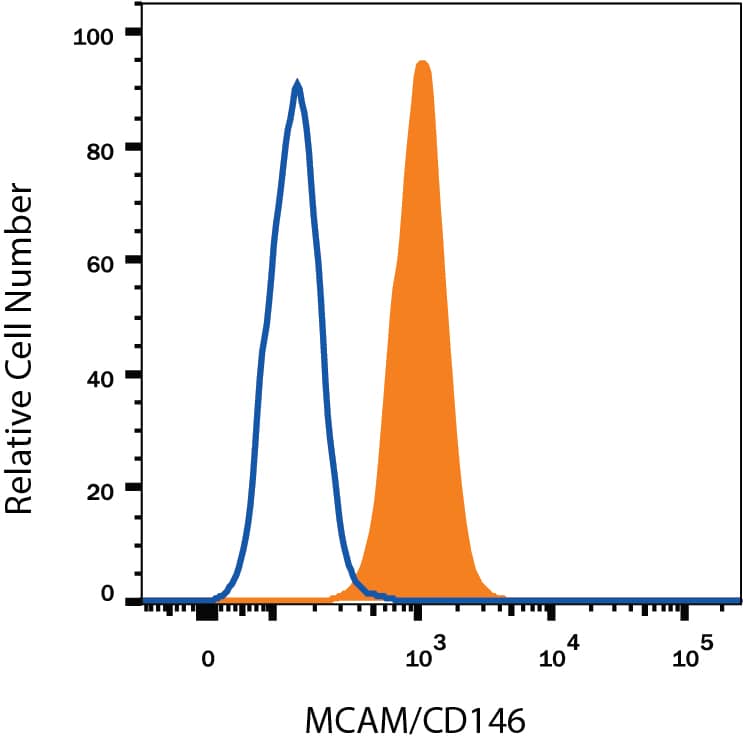Rat MCAM/CD146 Alexa Fluor® 594-conjugated Antibody
R&D Systems, part of Bio-Techne | Catalog # FAB3250T


Key Product Details
Species Reactivity
Applications
Label
Antibody Source
Product Specifications
Immunogen
Arg19-Lys560
Accession # Q9EPF2
Specificity
Clonality
Host
Isotype
Scientific Data Images for Rat MCAM/CD146 Alexa Fluor® 594-conjugated Antibody
Detection of MCAM/CD146 in PC‑12 Rat Cell Line by Flow Cytometry.
PC-12 rat adrenal pheochromocytoma cell line was stained with Mouse Anti-Rat MCAM/CD146 Alexa Fluor® 594-conjugated Monoclonal Antibody (Catalog # FAB3250T, filled histogram) or isotype control antibody (Catalog # IC003T, open histogram). View our protocol for Staining Membrane-associated Proteins.Applications for Rat MCAM/CD146 Alexa Fluor® 594-conjugated Antibody
Flow Cytometry
Sample: PC-12 rat adrenal pheochromocytoma cell line
Formulation, Preparation, and Storage
Purification
Formulation
Shipping
Stability & Storage
- 12 months from date of receipt, 2 to 8 °C as supplied.
Background: MCAM/CD146
Melanomia Cell Adhesion Molecule (MCAM), also known as CD146 and MUC18, is a putative Ig-superfamily adhesion molecule that is expressed on endothelial cells and a variety of tumor cells. MCAM is associated with tumor progression and metastasis and may be involved in embryonic neural development. An alternately spliced isoform of rat MCAM has a 40 residue deletion in the cytoplasmic domain. Within the extracellular region, rat MCAM shares 72% and 90% amino acid sequence identity with human and mouse MCAM, respectively.
Long Name
Alternate Names
Gene Symbol
UniProt
Additional MCAM/CD146 Products
Product Documents for Rat MCAM/CD146 Alexa Fluor® 594-conjugated Antibody
Product Specific Notices for Rat MCAM/CD146 Alexa Fluor® 594-conjugated Antibody
This product is provided under an agreement between Life Technologies Corporation and R&D Systems, Inc, and the manufacture, use, sale or import of this product is subject to one or more US patents and corresponding non-US equivalents, owned by Life Technologies Corporation and its affiliates. The purchase of this product conveys to the buyer the non-transferable right to use the purchased amount of the product and components of the product only in research conducted by the buyer (whether the buyer is an academic or for-profit entity). The sale of this product is expressly conditioned on the buyer not using the product or its components (1) in manufacturing; (2) to provide a service, information, or data to an unaffiliated third party for payment; (3) for therapeutic, diagnostic or prophylactic purposes; (4) to resell, sell, or otherwise transfer this product or its components to any third party, or for any other commercial purpose. Life Technologies Corporation will not assert a claim against the buyer of the infringement of the above patents based on the manufacture, use or sale of a commercial product developed in research by the buyer in which this product or its components was employed, provided that neither this product nor any of its components was used in the manufacture of such product. For information on purchasing a license to this product for purposes other than research, contact Life Technologies Corporation, Cell Analysis Business Unit, Business Development, 29851 Willow Creek Road, Eugene, OR 97402, Tel: (541) 465-8300. Fax: (541) 335-0354.
For research use only